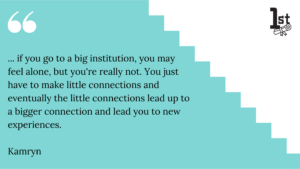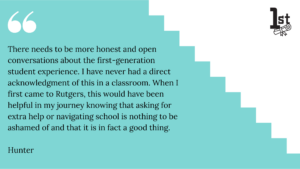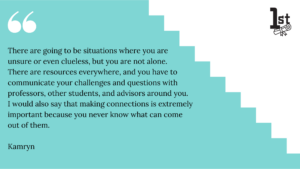Uncertainty About Belonging Is Common

Belonging uncertainty (Walton & Cohen, 2007) is when learners feel like they don’t belong, or wonder about the quality of their connection with others in their classes and at college. Although we have all experienced belonging uncertainty at some point in our lives, this phenomenon may be especially common or severe for first-generation students in the college environment.
Learning requires taking risks and working hard. Mitigating belonging uncertainty removes barriers so learners can engage with, and therefore benefit from, the challenging learning environment you build in your teaching. In studies that compare experiences of first-generation learners with continuing-generation learners, when first-generation learners experience belonging uncertainty, it more negatively impacts their engagement with learning (Gillen-O’Neel, 2021), their motivation, and ultimately their academic achievement (Totonchi, et al., 2023). This puts first-generation learners at a disadvantage and contributes to equity gaps in academic success.
“Belonging comes from the community and is not willfully acquired by individual students” (Nunn, 2021, p. 94). The following sections detail some ways that we as instructors can establish a classroom community that nurtures our learners’ sense of belonging.
Strategies
-

Why?
When experiencing belonging uncertainty, we seek cues to affirm whether or not we belong. Getting a bad grade on a high stakes midterm or final exam is a big flashing cue that can signal to learners ‘you don’t belong!’ It can be helpful to tell students about a time you got a lower grade than you had hoped and let them know that nearly all Rutgers students get at least one grade that they’ve never seen before, often in their first year.
Frequent, lower-stakes assessments can reduce the strength of this signal and give you, as the instructor, many opportunities to send the message that struggle is a productive part of the learning process. At the same time, though, we know that grading many low-stakes assessments can present sizable labor and logistics issues, especially in larger classes.
The good news is that there are sustainable ways to provide feedback that encourages a growth mindset, normalizes struggle, nurtures a sense of belonging, and ultimately enhances learning by improving learners’ understanding of their own learning process. Classroom Assessment Techniques (CATs) are brief low-stakes activities that can quickly gauge learning. They are often anonymous, reviewed in bulk for common themes (i.e., not individually graded and returned), and they provide the instructor and learners with feedback on learning that is delivered in sum to the whole class.
How?
The book Classroom Assessment Techniques by Angelo and Cross (which you can check out from the Rutgers Library) details many CATs. Here are two simple CATs that are easily implementable in any discipline:
Muddiest Point
This technique can be used at the end of any aspect of a class, including the end of a lecture or lab, the end of a unit, or when wrapping up a topic. It can be conducted using pen and paper or can be collected digitally using a survey tool or polling technology. Give students a short amount of time to briefly and anonymously share what they are most confused or uncertain about. This provides you and your learners with information about their learning and can help inform your planning for the next class meeting, activity, unit, or review.
When you have hundreds of students, you can skim or sample these anonymous contributions to collect a sense of general patterns of confusion. This allows you to intentionally select extra problem questions or to address common misconceptions.
Muteti et al., (2022) incorporated the “Muddiest Point” activity detailed above and found that the activity improved performance among first-generation learners.
Assessment Wrapper
After an assessment or exam, ask learners to reflect on how they approached the assessment, what they got right, what they got wrong and why, and what they might keep doing or do differently next time. This metacognitive practice redirects students from the grade received onto their study practices and strategies for improving next time.
When reviewing learners’ assessment wrappers, you can search for common themes of things learners did well and areas for improvement. Highlighting common areas of challenge can convey to students struggling with belonging uncertainty that they are not alone in experiencing challenges; discussing how to improve in response to these challenges is a way to convey to students that struggle is a productive part of learning. With a large group, you can sift through the pile in search of a range of examples, for instance, strong examples, medium examples, and examples that show quite a bit of room for improvement. Use these anonymous examples to provide constructive feedback to the whole class on what was done well and what could be done to improve.
Check out more Classroom Assessment Techniques through these CAT resources from Vanderbilt University’s Center for Teaching.
References
Angelo, T. A., & Cross, K. P. (1993). Classroom assessment techniques : A handbook for college teachers (2nd ed.). Jossey-Bass Publishers.
Muteti, C. Z., Kerr, T., Mwavita, M., & Mutambuki, J. M. (2022). Blending muddiest point activities with the common formative assessments bolsters the performance of marginalized student populations in general chemistry. Chemistry Education Research and Practice, 23(2), 452–463. 10.1039/d1rp00314c
-

Why?
We all have stories of times when we questioned our belonging. When we share how our own belonging uncertainty dissipated over time, or times when we felt relief after reaching out to others, we highlight how these feelings can be temporary and ways to manage and even mitigate these feelings. Sharing our experiences of struggle with learners normalizes these feelings (Artze-Vega et al., 2023, pp. 129).
Finally, and maybe even most importantly, when we are vulnerable with our learners, we enhance a connection which has a significant positive impact on student learning. And if students are aware of instructor identities that may otherwise be concealed if not intentionally disclosed, such as being first-generation, this may enhance learners’ sense of representation among their instructors (Busch, et al., 2024).
How?
If you are first-generation, consider sharing your own story. When learners see people like themselves in successful roles, it may send a powerful message of belonging (Supiano, 2024). However, in their research on STEM instructors disclosing concealable stigmatized identities, the authors note that for some, revealing identities may risk consequences, and so instructors should consider this before doing so (Busch, et al., 2024).
For any belonging story that may be relevant to share, here is a suggested guideline for ensuring optimal impact.
The Student Experience Project suggests an approach to crafting your belonging story:
- Briefly describe an experience that evoked belonging uncertainty for you.
- Acknowledge belonging concerns as real and valid.
- Communicate that it is common to question one’s belonging when facing challenges.
- Describe how your sense of belonging improved over time with the use of steps to build relationships and ties to the campus community.
Be sure to review best practices (including common pitfalls to avoid) to ensure that your belonging story doesn’t unintentionally undermine your learners’ experiences.
References
Artze-Vega, I., Darby, F., Dewsbury, B., & Imad, M. (2023). The Norton guide to equity-minded teaching. W.W. Norton and Company.
Busch, C. A., Araghi, T., He, J., Cooper, K. M., & Brownell, S. E. (2024). Beyond gender and race: The representation of concealable identities among college science instructors at research institutions. CBE Life Sciences Education, 23(2), ar9. 10.1187/cbe.23-09-0170
Supiano, B. (2024, April 18). Teaching: An overlooked way professors can be role models. The Chronicle of Higher Education. https://www.chronicle.com/newsletter/teaching/2024-04-18?utm_source=Iterable&utm_medium=email&utm_campaign=campaign_9650110_nl_Academe-Today_date_20240423&cid=at&sra=true
-

Why?
Having a growth mindset means that you believe that learners can improve and grow with the right strategies (Dweck, 2006). We communicate whether or not we have a growth mindset in the way we give feedback. Using growth mindset messaging in our feedback communicates that you have reasonably high standards, and that you believe the learner has the ability to learn and to meet these expectations. This kind of feedback supports the learner’s own growth mindset and improves student learning outcomes. This is especially true for first-generation learners; in a study on growth mindset messaging, first-generation learners responded to this messaging with an uptick in their use of course materials, which ultimately increased their academic performance (Canning et al., 2024).
How?
- Here are some specific examples of feedback messages that support a growth mindset in math (Packensky-Brock, 2020).
- In an interview with Geoff Cohen for the Harvard Edcast podcast entitled The Crisis of Belonging, Cohen described a study in which students received feedback on their writing with the preface “I’m giving you this critical feedback because I have high standards and because I believe in your potential to reach them.” Including this phrase before the feedback significantly increased student revisions on their writing.
- Canning et al., (2024) provided growth mindset messaging after posting grades for the first two exams in a biology course. They found that grades improved for the group that received the growth mindset messaging compared to the control group, and that grades improved the most for first-generation learners.
References
Anderson, J. (Host). (2023, March 3rd). A crisis of belonging [Audio podcast episode]. In Edcast. Harvard Graduate School of Education. https://www.gse.harvard.edu/ideas/edcast/23/03/crisis-belonging
Canning, E. A., White, M., & Davis, W. B. (2024). Growth mindset messages from instructors improve academic performance among first-generation college students. CBE Life Sciences Education, 23(2), ar14. 10.1187/cbe.23-07-0131
Dweck, C. S. (2006). Mindset: The new psychology of success. Random house.
Pacansky-Brock, M. (2020). How to humanize your online class, version 2.0 [Infographic]. https://brocansky.com/humanizing/infographic2
-

Why?
As a group, first-generation learners have a higher representation of students of color and a lower median parental income compared to their continuing generation peers. Microaggressions are “the everyday, subtle, intentional — and oftentimes unintentional — interactions or behaviors that communicate some sort of bias toward historically marginalized groups.” Although the term suggests that these acts are small, they are usually not isolated incidents, and can have a big impact cumulatively—especially on groups like first-generation learners, who are more likely to hold marginalized identities (Ellis et al., 2019; Garriott et al., 2023; Gray et al., 2018). Similarly, bias-related incidents may occur in any course. These types of incidents are acts “motivated in whole or in part by prejudice against a person or group, based on a person or community’s actual or perceived identities” as defined by the Rutgers New Brunswick Division of Student Affairs.
As instructors, we can nurture a conducive learning environment for our learners by doing what we can to prevent microaggressions and bias incidents from happening, and dealing with them directly if they do occur. When instructors address microaggressions and bias statements effectively, learners feel more protected, which promotes a sense of safety in the classroom environment; when instructors do not directly prevent or address microaggressions or bias statements in the classroom, biased and harmful ideology is reinforced in the classroom climate (Sue et al., 2009) which can negatively impact learning.
How?
- Setting up an inclusive environment can help mitigate discriminatory behavior and unproductive conflict and prepare learners for productive discussions. Refer to the Rutgers Institute for Teaching, Innovation, and Inclusive Pedagogy’s (TIIP) guide Preparing for the Upcoming Semester: Fostering Inclusive Learning Environments.
- Include a statement on your syllabus that communicates that you are dedicated to an inclusive learning environment and that microaggressions and bias incidents will not be tolerated.
- Be aware of how to report bias incidents and include and point out on your syllabus a link to bias incident reporting procedures.
- Take time at the beginning of the semester to convey community guidelines. This is especially important in classes that involve discussion of contentious topics, but useful in all course environments. Consider co-creating these guidelines as a class and keep them in your Canvas space for easy reference.
- Prepare for the possibility that microaggressions or bias incidents will occur, and that they can appear in any class, not just in courses that touch on controversial topics.
- For specific strategies for how to handle microaggressions if they happen, refer to this video resource from the Rutgers Institute for Teaching, Innovation, and Inclusive Pedagogy (TIIP). Also refer to TIIP’s guide mentioned above for step-by-step approaches, such as the RAVEN approach, to directly address microaggressions:
- Redirect the interaction to prevent further harms
- Ask probing questions to better understand the intent of the comment (e.g. What did you mean by that?)
- Clarify Values (e.g., revisit the classroom guidelines)
- Emphasize your own thoughts and feelings
- Ask yourself if you feel ready to identify and directly address microaggressions and bias incidents. If you need support, make use of Rutgers resources such as The Center for Social Justice Education and LGBT Communities’ customizable workshops that can address microaggressions. There are also bias training and inclusive community building opportunities with Rutgers Equity and Inclusion, such as the Speak Up! Universitywide Bias Prevention Campaign.
References
Ellis, J. M., Powell, C. S., Demetriou, C. P., Huerta-Bapat, C., & Panter, A. T. (2019). Examining first-generation college student lived experiences with microaggressions and microaffirmations at a predominately white public research university. Cultural Diversity & Ethnic Minority Psychology, 25(2), 266–279. 10.1037/cdp0000198
Garriott, P. O., Ko, S., Grant, S. B., Jessen, M., & Allan, B. A. (2023). When race and class collide: Classism and social-emotional experiences of first-generation college students. Journal of College Student Retention, 25(3), 509–532. 10.1177/1521025121995483
Gray, B., Johnson, T., Kish-Gephart, J., & Tilton, J. (2018). Identity work by first-generation college students to counteract class-based microaggressions. Organization Studies, 39(9), 1227–1250. 10.1177/0170840617736935
Limbong, A. (Host). (2020, June 9th). Microaggressions are a big deal: How to talk them out and when to walk away [Audio podcast episode]. In Lifekit. NPR. https://www.npr.org/2020/06/08/872371063/microaggressions-are-a-big-deal-how-to-talk-them-out-and-when-to-walk-away
Sue, D. W., Lin, A. I., Torino, G. C., Capodilupo, C. M., & Rivera, D. P. (2009). Racial microaggressions and difficult dialogues on race in the classroom. Cultural Diversity & Ethnic Minority Psychology, 15(2), 183–190. 10.1037/a0014191
References
Gillen-O’Neel, C. (2021). Sense of belonging and student engagement: A daily study of first- and continuing-generation college students. Research in Higher Education, 62(1), 45–71. 10.1007/s11162-019-09570-y
Nunn, L. M. (2021). College belonging : How first-year and first-generation students navigate campus life. Rutgers University Press. 10.36019/9781978809536
Totonchi, D. A., Tibbetts, Y., Williams, C. L., Francis, M. K., DeCoster, J., Lee, G. A., Hull, J. W., & Hulleman, C. S. (2023). The cost of being first: Belonging uncertainty predicts math motivation and achievement for first-generation, but not continuing-generation, students. Learning and Individual Differences, 107, 102365. 10.1016/j.lindif.2023.102365
Walton, G. M., & Cohen, G. L. (2007). A question of belonging: Race, social fit, and achievement. Journal of Personality and Social Psychology, 92(1), 82–96. 10.1037/0022-3514.92.1.82